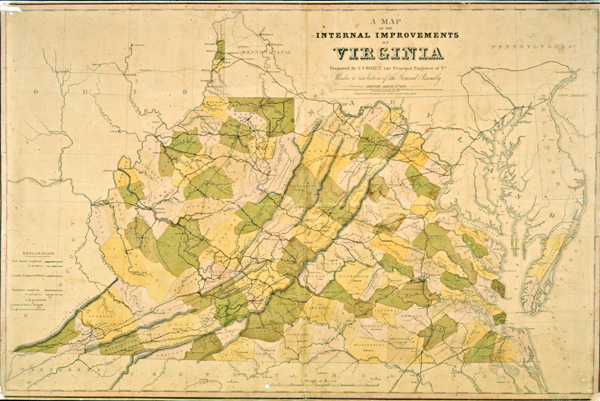 After a Governor's Fellowship piqued my interest in Virginia History, I read a book called From Virginia Boubonism to Byrd, 1870-1925 by Allen W. Moger which opened my eyes to a lot of state history. As the General Assembly continues to debate the merits of increasing the state's debt load, I thought it might be useful to revisit the history of why Virginia's debt limits exist. Today, most people don't have any historical understanding as to why these limits came into existence.
After a Governor's Fellowship piqued my interest in Virginia History, I read a book called From Virginia Boubonism to Byrd, 1870-1925 by Allen W. Moger which opened my eyes to a lot of state history. As the General Assembly continues to debate the merits of increasing the state's debt load, I thought it might be useful to revisit the history of why Virginia's debt limits exist. Today, most people don't have any historical understanding as to why these limits came into existence.Prior to the Civil War, the Commonwealth had purchased stock in companies owning several turnpike, toll bridge, canal, and water and rail transportation improvements (click here for 1848 VA Internal Improvement Map). These improvements were financed using debt instead of cash which is the more modern practice.
After the Civil War, much of the improvements in Virginia were destroyed. The improvements in West Virginia were fine, but West Virginia's share of the debt was in dispute. The debt was owned by Yankee and British investors.
Many of the early post-Reconstruction legislative battles were driven by this debt and satisfaction the debt which amounted to $45 million in 1870 which at that time was a massive amount of money.
During Reconstruction, Virginia's government had been controlled by freed slaves and poor whites, largely due to the disenfranchisement of Confederate veterans. As Reconstruction closed, Confederates were enfranchised and the Democratic Party's predecessor, the Conservative Party was formed in reaction to governance by freed slaves and increased suffrage among poorer whites.
In terms of Virginia's debt, the Conservatives were focused on preserving Virginia's honor, moral obligation, and good name. Also known as "Funders," they were white, institutional and wealthy. They became known as the "Funders" and ulimately most affiliated with this group became Democrats.
The new Constitution of 1870 had called for the state to fund a public education system for hte first time, but the debt situation was utterly crippling. After the Conservatives wrested control of government in 1873, they recapitalized Virginia's debt with new bonds at 6% interest with redeemable coupons. The coupons could be used to "pay" taxes.
At the time, Virginia's taxes were actually higher than in New England because of this debt. Before Virginia had an income tax, sales tax or gas tax, and before real estate taxes were reserved to localties, Virginia's government was largely funded with real estate taxes. In 1870, Virginia's real estate tax of $0.50 per $100 of value was 35% more than the average real estate tax in the northern states and 50% higher than Pennsylvania, New York, and the six New England states.
The budget situation grew so bad that in 1875, the Commonwealth had $1 million less revenue than its debt interest payments alone. Part of this was caused because wealthier Virginians could buy the bond coupons from investors at a discounted price and then pay their taxes using the face value of the bond coupons.
 In 1879, the Commonwealth even deliberately refused to make mandatory payments for free public schools because it preferred debt payments over other obligations. Pickett's Charge hero Governor Kemper (left) resented this legacy and tried his best to convince the General Assembly to reform the tax structure to no avail.
In 1879, the Commonwealth even deliberately refused to make mandatory payments for free public schools because it preferred debt payments over other obligations. Pickett's Charge hero Governor Kemper (left) resented this legacy and tried his best to convince the General Assembly to reform the tax structure to no avail.The initial opposition to the Conservatives were the Republican Party.
 Eventually, the more liberal elements of the state became more organized in large part to the debt issue and were focused on readjusting the debt. They became known as "Readjusters" and ultimately became Republicans in the 1880's.
Eventually, the more liberal elements of the state became more organized in large part to the debt issue and were focused on readjusting the debt. They became known as "Readjusters" and ultimately became Republicans in the 1880's.The Readjusters were generally poorer, less educated, more diverse and felt that the Commonwealth had been destroyed by war, should not rebuild and pay this debt, and also wanted to maximize West Virginia's share. African Americans felt it was not their debt to pay given that they were enslaved when it was incurred. The Readjusters were led by former Confederal General William Mahone whose picture is to the right. The western part of the state leaned Readjuster while the relatively more affluent eastern Tidewater leaned Conservative/Funder.
One of the primary motives of the Readjusters in minimizing the Commonwealth's debt obligations was their interest in focusing limited government revenues on public education and improved social services to improve the condition of Virginia's poor.
Next: The Legacy of Debt, Part II: The Election of 1877 & Rise of the Readjusters.
Who Were the Readjusters
Wikipedia: Readjuster Party










Very interesting post Scott ... FWIW ... the cost you cite of $45,000,000 in 1879 ... adjusted to today's $ ... would be $1,023,436,411
ReplyDeleteThanks. Back then the states revenues were much less in proportion to what they are today.
ReplyDeleteThe state wasn't doing roads. It wasn't supporting nearly the same higher ed system that it does today. Public secondary schools were just getting started and barely existed. Corrections & law enforcement wasn't as robust and Medicaid didn't exist.
So $1B was a ton relative to what government was doing back then.